Andes to the Amazon, Peru 2005
2-16
July 2005
by
Henry Detwiler
We spent three nights in lodges along the Tambopata River, and one night
camping, accompanied by the sounds of the insects and the Jaguar's
growling..
Click on
thumbnail pictures for full-sized photos. 
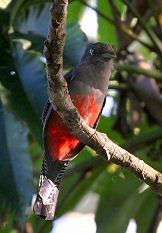
Blue-crowned Trogon
|
After flying into Puerto Maldonado, we met our guide Jorge, and
after a brief orientation, started out on our three-hour boat
ride some 30 miles upriver to our lodge. Along the way we
stopped for park permits, where we heard, and then saw this beautiful
trogon (and its mate). The river was murky from the mud of
gold prospectors washing the overburden off placer deposits until
we'd moved past one of the tributaries. |
The most commonly seen mammals were capybaras, the world's largest
rodent. We saw a couple of families lined up along the river
bank, keeping a wary eye on us, and also for the spectacled caimans
(photo on top of page) which no doubt find them an agreeable dinner.
Later in our trip we were also fortunate to see a family of Giant
Otters.
|

Capybara
|
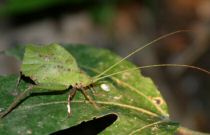
Leaf Katydid
Insects were common at all times, but particularly visible at night.
On our first night walk Jorge pointed out several of these leaf
katydids--their bodies look uncannily like leaves, even down to the
veins.
|
I found this Giant Roach in our room, and Jim
promptly captured it for our enjoyment--Jorge says it's the largest
species of roach in the world.
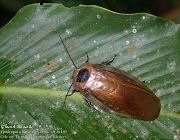
Giant Roach
|
|
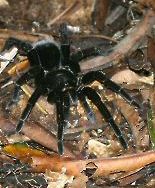
Tarantula
|
Spiders were common along the jungle trails,
especially at night. The largest of them were the tarantulas.
Jorge and I fished for them at their burrow entrances with long
pieces of grass. The spiders would sense the movement, and then
rush up their tunnel to investigate and grab the blade of grass, no
doubt hoping it was some kind of hapless stick insect. |
| One night we camped along the Rio Tambopata, and were
treated to an array of night sounds. Foremost was the growl/grunting of
a jaguar. Jim & I ventured from our campsite along the river,
but never spotted it--but the next morning we did find many tracks. |
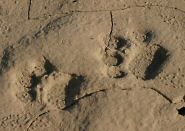
Jaguar Paw Prints |
|
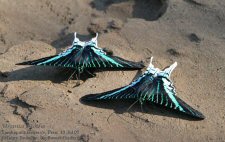
Urania Moths
|
The river banks contained many salt and mineral licks that were
attractive to butterflies and moths, which would gather there
by the dozens. These urania moths were very iridescent, and
provided a wonderful show along the jungle trails and on the
beaches.
|
Peru is home to some 1200 species of butterflies, including the huge,
incredibly beautiful morphos. We were fortunate to see these and
lots of others, in a rainbow of colors. Many of them, such as
the morphos & owls, and the one pictured on the right, were
nondescript with their wings closed, but very flashy with their wings
opened.
|
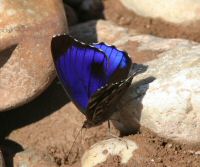
Butterfly (Elanica)
|
|
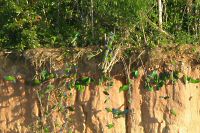
Blue-headed Parrots on the Clay Lick |
Visiting one of the macaw clay licks was a primary
motivator for this trip to the Amazon. Macaws and other
parrots "feed" on the clay to help with their digestion. We set up
across the river from the clay bank at first light, and watched as
Blue-headed and other parrots gathered for their morning dose of
medicine. Although few macaws actually landed on the clay this
morning, there were lots to see flying around. |
|
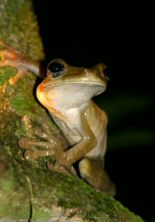
Goliath Tree Frog |
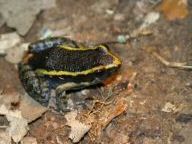
Spot-legged Poison Dart Frog
We were fortunate to see a good number of frogs on our walks,
including several of the Goliath Tree Frogs and one Poison Dart
Frog. This one can actually be handled, as long as you don't
have any cuts on your hand!
|
|
As is to be expected in the jungle, the
plant life was astoundingly varied and beautiful. Jorge
explained what many of the plants were used for, from food to birth
control to disease control. He crawled into this shell of a
tree, a strangler fig that had killed its host, and I followed suit. |
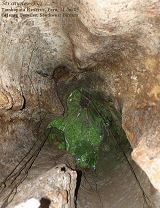
Strangler Fig
|
|

Hoatzin - Lake Sandoval
|
During our last full day in the Amazon Basin we
took a canoe trip around the palm-fringed Lake Sandoval. The
noisiest and most visible birds there were the Hoatzins,
prehistoric-looking birds that even have claws on their wings as
babies (to help them climb out of harm's way).
|
|
ON to PAGE
3 |
|